
On April 26, 1986, a series of explosions destroyed Chernobyl’s reactor No. 4, and several hundred staff and firefighters tackled a blaze that burned for 10 days and sent a plume of radiation around the world. More than 50 reactor and emergency workers were killed in the immediate aftermath.
The workers and emergency responders were not the only ones to risk their lives—a handful of photographers went to the scene as well, managing to capture images of some of the chaos and acts of heroism that took place in the weeks and months that followed.
Emergency crews responding to the accident used helicopters to pour sand and boron on the reactor debris. The sand was to stop the fire and additional releases of radioactive material; the boron was to prevent additional nuclear reactions.

Liquidators clean the roof of the No. 3 reactor. At first, workers tried clearing the radioactive debris from the roof using West German, Japanese, and Russian robots, but the machines could not cope with the extreme radiation levels so authorities decided to use humans. In some areas, workers could not stay any longer than 40 seconds before the radiation they received reached the maximum authorized dose a human being should receive in his entire life.
A few weeks after the accident, the crews completely covered the damaged unit in a temporary concrete structure, called the “sarcophagus,” to limit the further release of radioactive material.
The Soviet government also cut down and buried about a square mile of pine forest near the plant to reduce radioactive contamination at and near the site.
The accident occurred during a safety test meant to measure the ability of the steam turbine to power the emergency feedwater pumps of an RBMK-type nuclear reactor in the event of a simultaneous loss of external power and major coolant leak.
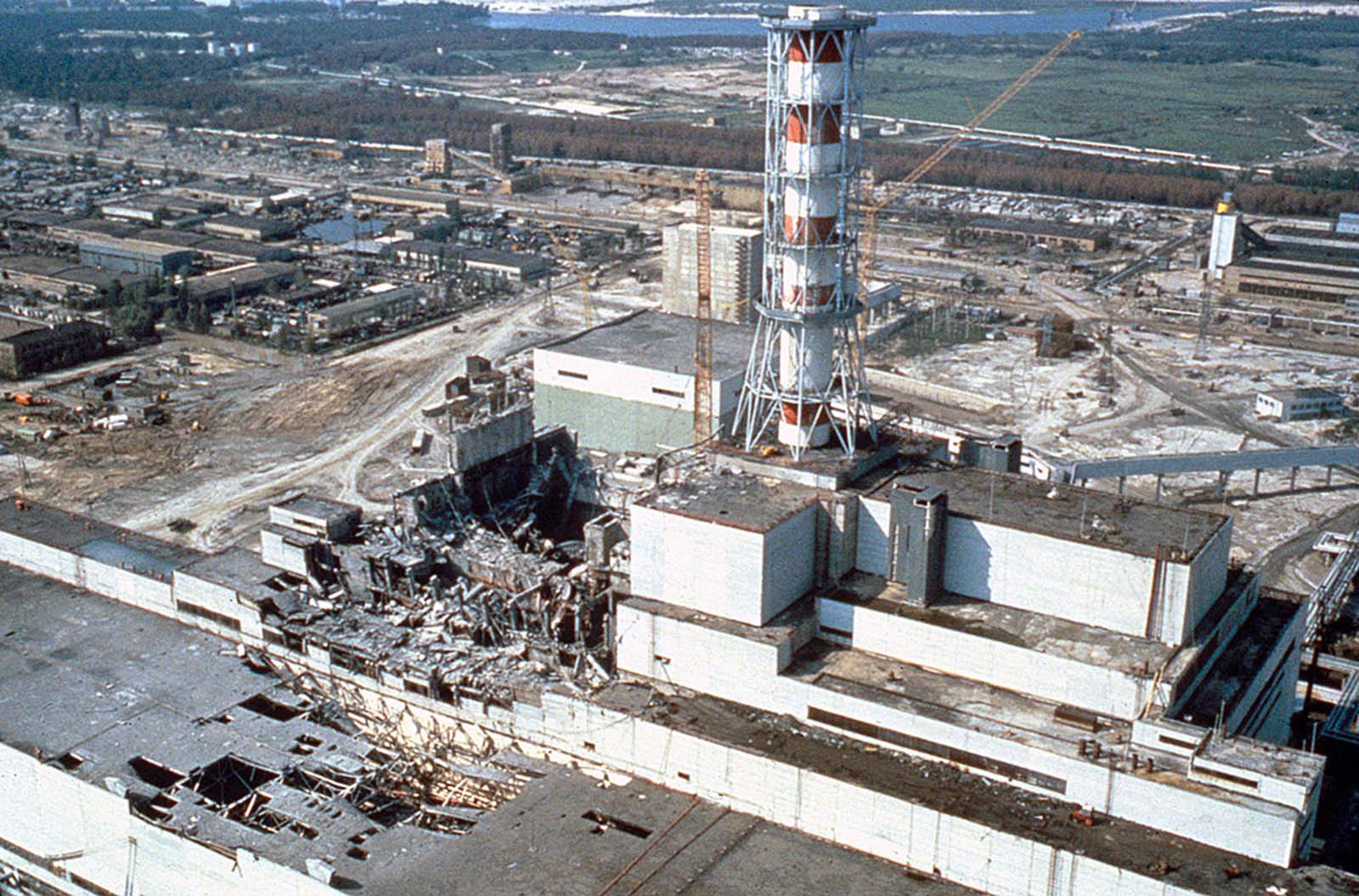
An aerial view of the damaged Chernobyl nuclear power plant, photographed a few weeks after the disaster, in May 1986.
During a planned decrease of reactor power in preparation for the test, the operators accidentally dropped power output to near-zero, due partially to xenon poisoning.
While recovering from the power drop and stabilizing the reactor, the operators removed a number of control rods which exceeded limits set by the operating procedures. Upon test completion, the operators triggered a reactor shutdown.
Due to a design flaw, this action resulted in localized increases in reactivity within the reactor (i.e., “positive scram”). This resulted in rupture of fuel channels, leading to a rapid decrease in pressure which caused the coolant to flash to steam.
This decreased neutron absorption, leading to an increase in reactor activity, which further increased coolant temperatures (a positive feedback loop). This process resulted in steam explosions and melting of the reactor core.
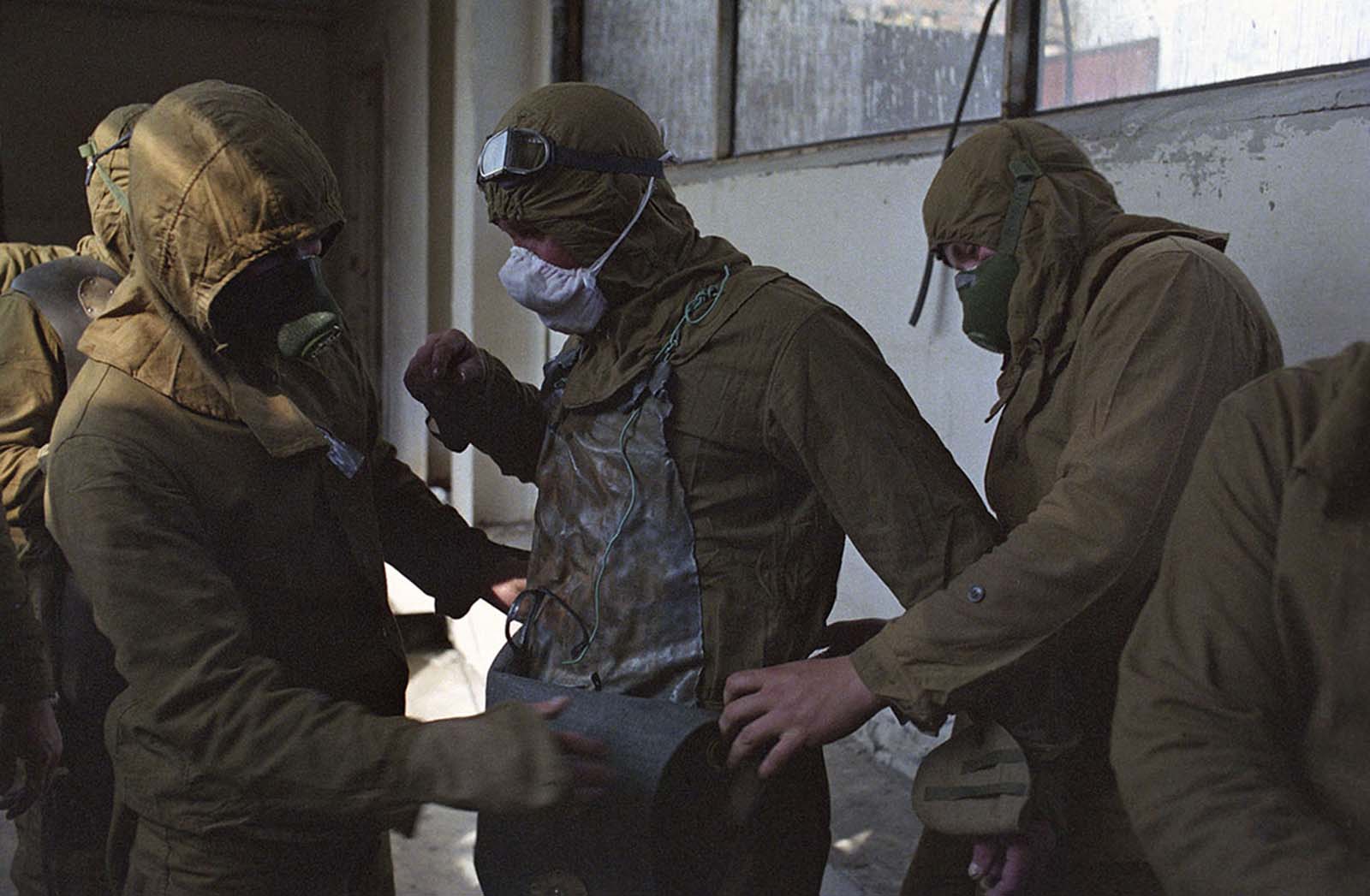
The majority of the liquidators were reservists ages 35 to 40 who were called up to assist with the cleanup operations or those currently in military service in chemical-protection units. The army did not have adequate uniforms adapted for use in radioactive conditions, so those enlisted to carry out work on the roof and in other highly toxic zones were obliged to cobble together their own clothing, made from lead sheets and measuring two to four millimeters thick. The sheets were cut to size to make aprons to be worn under cotton workwear, and were designed to cover the body in front and behind, especially to protect the spine and bone marrow.
The meltdown and explosions ruptured the reactor core and destroyed the reactor building.
This was immediately followed by an open-air reactor core fire which lasted until 4 May 1986, during which airborne radioactive contaminants were released and deposited onto other parts of the USSR and Europe.
Approximately 70% landed in Belarus, 16 kilometres (9.9 mi) away. The fire released about the same amount of radioactive material as the initial explosion.
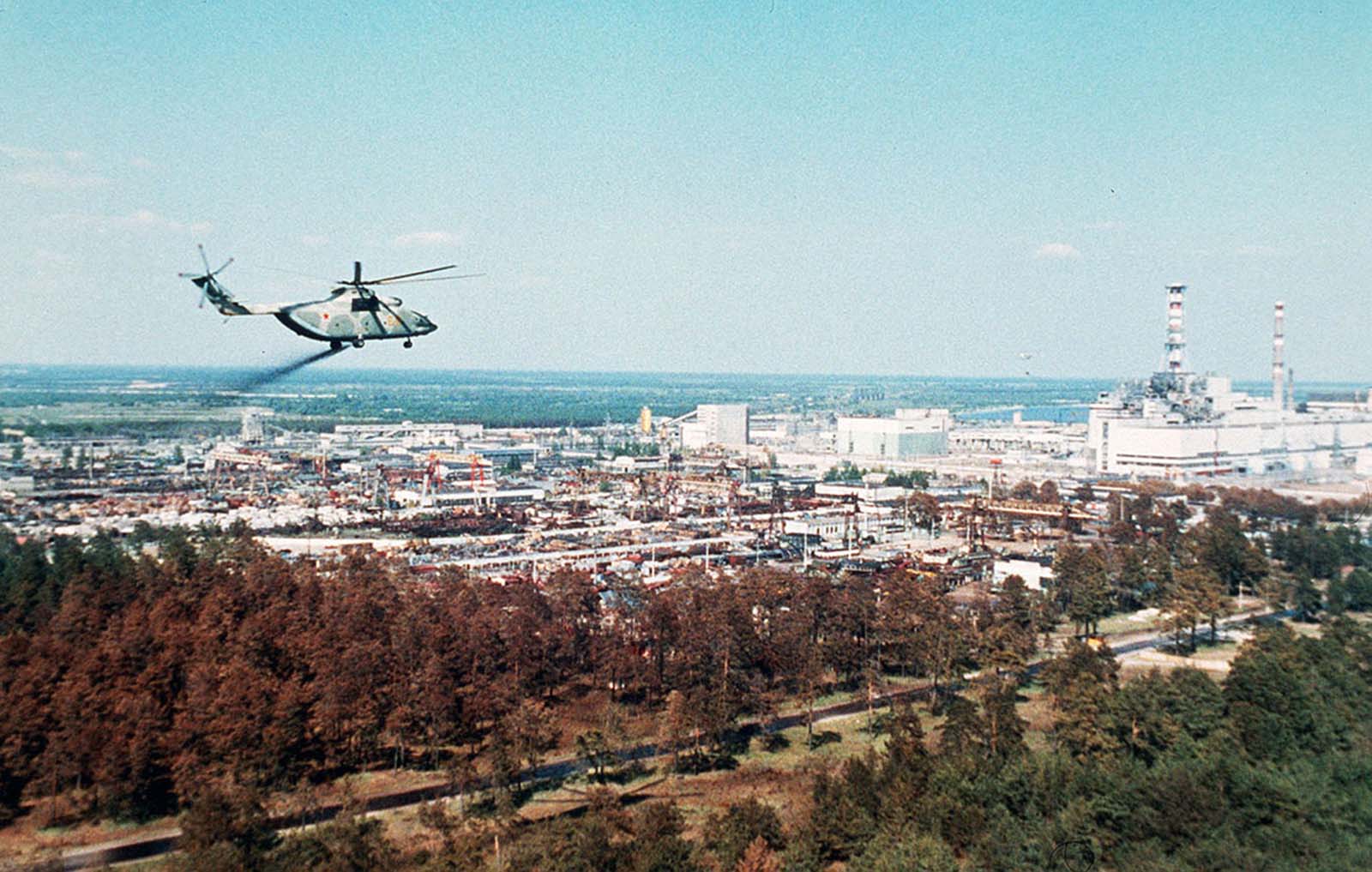
A military helicopter spreads sticky decontamination fluid supposed to reduce the spread of radioactive particles around the Chernobyl nuclear plant a few days after the disaster.
In response to the initial accident, a 10-kilometre (6.2 mi) radius exclusion zone was created 36 hours after the accident, from which approximately 49,000 people were evacuated, primarily from Pripyat.
Following the reactor explosion, which killed two engineers and severely burned two more, a massive emergency operation to put out the fire, stabilize the reactor, and clean up the ejected radioactive material began.
During the immediate emergency response, 237 workers were hospitalized, of which 134 exhibited symptoms of acute radiation syndrome (ARS). Among those hospitalized, 28 died within the following three months, all of whom were hospitalized for ARS.
In the following 10 years, 14 more workers (9 who had been hospitalized with ARS) died of various causes mostly unrelated to radiation exposure.
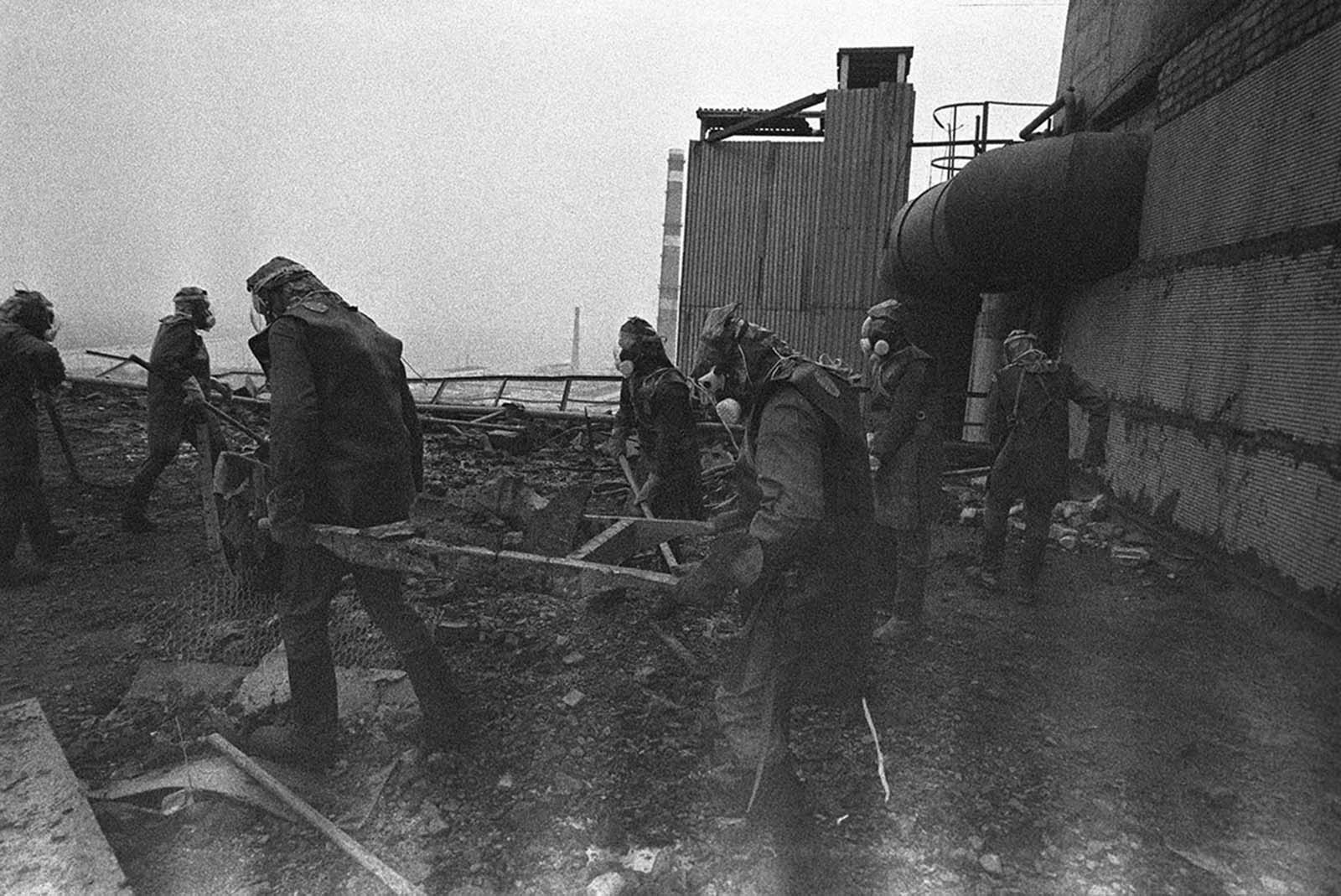
Liquidators clear radioactive debris from the roof of the No. 4 reactor, throwing it to the ground where it will later be covered by the sarcophagus. These “biological robots” have only seconds to work—time to place themselves by a pile of debris, lift a shovel load, and throw it among the ruins of reactor No. 4.
Following the disaster, Pripyat was replaced by the new purpose-built city of Slavutych. The USSR built the protective Chernobyl Nuclear Power Plant sarcophagus by December 1986.
It reduced the spread of radioactive contamination from the wreckage and protected it from weathering.
The confinement shelter also provided radiological protection for the crews of the undamaged reactors at the site, which were restarted in late 1986 and 1987.

A team of human liquidators prepares to clear radioactive debris off the roof of the No. 4 reactor.
However, this containment structure was only intended to last for 30 years, and required considerable reinforcement in the early 2000s.
The Shelter was supplemented in 2017 by the Chernobyl New Safe Confinement which was constructed around the old structure.
This larger enclosure aims to enable the removal of both the sarcophagus and the reactor debris while containing the radioactive materials inside. Clean-up is scheduled for completion by 2065.

A liquidator, outfitted with handmade lead shielding on his head, works to clean the roof of reactor No. 3.
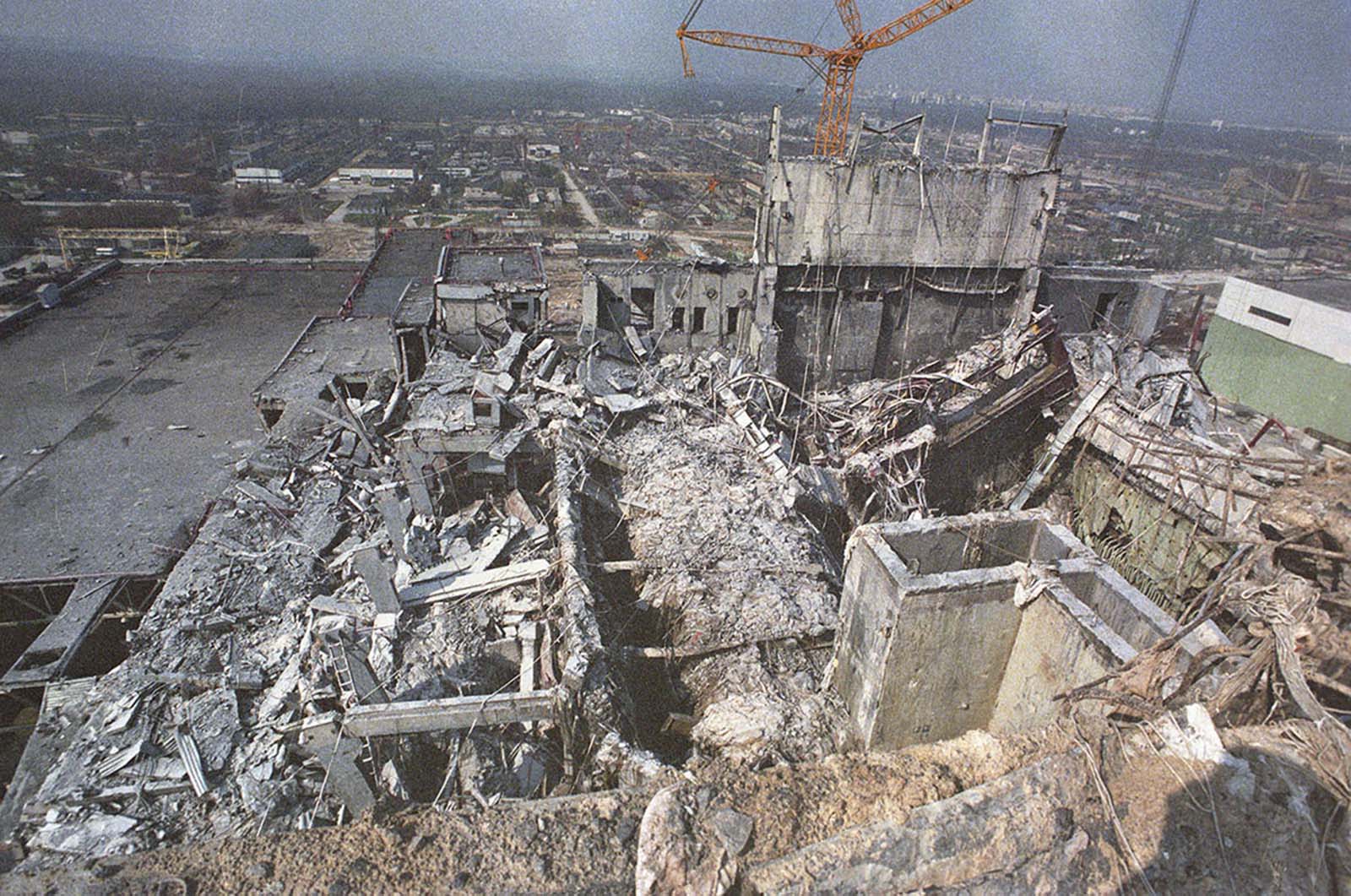
The remains of the No. 4 reactor, photographed from the roof of reactor No. 3.

A photo from Soviet television shows a man who was injured in the blast at Chernobyl as he receives medical attention.

A Soviet technician checks water taken from a stream near Kiev for radiation on May 9, 1986. Checks were being performed hourly to be certain that water supplies were safe to use in the wake of the Chernobyl nuclear-plant accident.

A Soviet technician prepares a tank truck with a solution designed to decontaminate people’s clothes and equipment in Kiev on May 9, 1986.

A Soviet technician checks the toddler Katya Litvinova during a radiation inspection of residents in the village of Kopylovo, near Kiev, on May 9, 1986.

An aerial view of the damaged Chernobyl nuclear plant undergoing repair and containment work in 1986.

A bulldozer digs a large trench in front of a house before burying the building and covering it with earth. This method was applied to entire villages that were contaminated after the Chernobyl disaster.

An interior photo of a still-functioning section of the Chernobyl nuclear-power plant taken a few months after the disaster in 1986.

A Chernobyl nuclear-power-plant worker holds a dosimeter to measure radiation levels, with the under-construction sarcophagus, meant to contain the destroyed reactor, visible in the background, in this photo taken in 1986.

Following orders issued by Soviet authorities to mark the end of cleanup operations on the roof of the No. 3 reactor, three men were requested to post a red flag atop the chimney overlooking the destroyed reactor, reached by climbing 78 meters up a spiral staircase. The flag bearers were sent despite the dangers posed by heavy radiation, and after a group of liquidators had already made two failed attempts by helicopter. The radiation expert Alexander Yourtchenko carried the pole, followed by Valéri Starodoumov with the flag, and Lieutenant Colonel Alexander Sotnikov with the radio. The whole operation was timed to last only 9 minutes, given the high radiation levels. At the end, the trio were rewarded with a bottle of Pepsi (a luxury in 1986) and a day off.

At Moscow’s No. 6 clinic, which specializes in radiation treatment, a patient recovers after a bone-marrow operation. A doctor examines the patient in a sterile room. The examination is carried out in an individual, air-conditioned chamber via specially created openings to avoid direct contact and contamination.
The Chernobyl accident attracted a great deal of interest. Because of the distrust that many people had in the Soviet authorities, which engaged in a major cover-up of the disaster, a great deal of debate about the situation at the site occurred in the First World during the early days of the event.
Because of defective intelligence based on satellite imagery, it was thought that unit number three had also had a dire accident. Journalists mistrusted many professionals, and they in turn encouraged the public to mistrust them.
The accident raised already heightened concerns about fission reactors worldwide, and while most concern was focused on those of the same unusual design, hundreds of disparate nuclear reactor proposals, including those under construction at Chernobyl, reactors numbers 5 and 6, were eventually canceled.
With ballooning costs as a result of new nuclear reactor safety system standards and the legal and political costs in dealing with the increasingly hostile/anxious public opinion, there was a precipitous drop in the rate of new reactor construction after 1986.
The accident also raised concerns about the cavalier safety culture in the Soviet nuclear power industry, slowing industry growth and forcing the Soviet government to become less secretive about its operating procedures.
The government coverup of the Chernobyl disaster was a catalyst for glasnost, which “paved the way for reforms leading to the Soviet collapse.”
Numerous structural and construction quality issues, as well as deviations from the original plant design, had been known to KGB since at least 1973 and passed on to the Central Committee, which took no action and classified the information.
(Photo credit: Igor Kostin / Boris Yurchenko / Laski Diffusion / Volodymyr Repik / Sygma via Getty).
Updated on: October 13, 2024
Any factual error or typo? Let us know.



